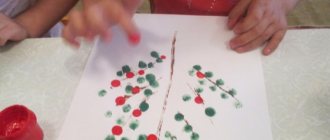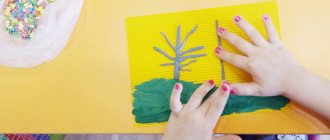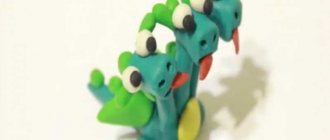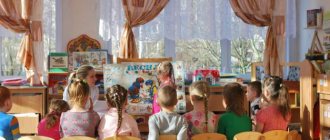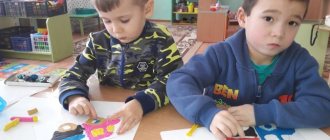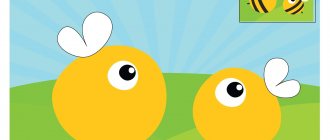Planar modeling
You should start introducing your child to plasticineography by learning the skills of drawing with longitudinal strokes. Show your child how to rub several multi-colored slices of crushed plasticine over the surface. Then start “coloring” geometric shapes in the form of the sun, a large flower, a pyramidal poplar, and animals. Children often use only their index finger when working, but try to get them to use both limbs. Such exercises will help improve the synchronization of the brain hemispheres.
Open lesson on art "Plasticineography"
Open lesson on fine arts in grade 6 “B”.
Akkol Secondary School No. 4
Teacher: Belozerova E.N.
Subject :
Painting techniques. Drawing pictures with plasticine (plasticineography).
Target :
to activate the knowledge of students, introduce and teach how to perform paintings with plasticine.
Tasks: 1
. Educational: introduce unconventional drawing techniques.
2.
Developmental: develop creative thinking, imagination, attentiveness, sensory and motor skills of the hands, eye, perseverance, patience, accuracy of execution.
3.
Educational: to form a correct idea of plastinography.
Lesson type
: lesson is a game.
Methods:
explanatory, visual, practical, group work.
Equipment :
interactive whiteboard, plasticine, boards, stacks, colored cardboard, handouts.
During the classes:
- Organizational part: greeting, checking the presence of students, checking the readiness of students and the classroom for the lesson - 2 minutes.
- Divide into 3 groups using colored cards (children sit down) come up with a team name -2 min. Jury selection.
- Checking your understanding of the topic of the last lesson using the cartoon “Plasticine Crow” - 2 min
- Explanation of new material (slide show) - 8 min
1DRAWING WITH PLASTICINE is an art at the intersection of two classical visual genres: “flat” painting and three-dimensional image, that is, sculpture. Plasticine is a most fertile material for an artist, but it seems that it is not yet sufficiently appreciated.
If you know and use the secrets of plasticine , you can create not just crafts, but real paintings from plasticine - from thin canvases, almost indistinguishable from painting, to convex bas-reliefs.
2Our next lesson at the drawing school is devoted to another non-traditional technique of fine art - artistic plasticineography.
Plasticineography is a technique whose principle is to create a molded picture with plasticine on a paper, cardboard or other base, thanks to which the images are more or less convex, semi-volume.
Plasticine is a plastic and soft material for children's creativity, which has the ability to take and hold a given shape.
3Plasticine (different colors).
Plastic boards for performing work.
Stacks.
Cardboard (plain and colored), preferably thick.
You can also creatively use any dense surface: wood, glass, plastic.
Waste material - for creating fantasy game images: paper of different textures, candy wrappers, seeds, grains, buttons, plastic containers, etc.
- 4. making decorative moldings of various shapes, • pinching, • flattening, • pulling parts away from the general shape, • tightly connecting parts by smearing one part to another, • and even mixing different colors of plasticine to obtain intermediate shades - the technique of “pouring one color into another".
- First task: paint a still life on the handout as shown on the slide, -10 min. Show work for evaluation by the jury. Perform targeted rounds.
- Second task: color the winter landscape on the handout, using mixing different colors of plasticine to obtain intermediate shades - 10 min. Display of works for evaluation by the jury. Perform targeted rounds.
- Third task: listen to the melody; after listening to the melody, express your associations in a three-dimensional drawing on the disk (slide show) - 8 minutes and talk about your drawing. Perform targeted rounds.
- Lesson summary - 3 min: reflection
— What is the name of the topic of today's lesson?
-What is “plasticineography”?
— In what ways can you apply imprints on a drawing?
-What other materials can be used in plasticineography?
The jury's word. Rewarding.
Grading for the lesson.
D/Z: make a drawing from plasticine on the theme: “My Kazakhstan” for the exhibition.
Cleaning workplaces and offices
Sausages with spirals
Preschoolers can already make simple plasticine compositions. To do this, you need to roll the material into thin rods. This requires maximum patience, attentiveness and accuracy - such character qualities are developed by such activities. By combining multi-colored stripes, children depict cosmic pictures with stars, a winter forest, the underwater world, and autumn trees. You can make beautiful canvases if you place three-dimensional drawings.
A more complex form of creativity is the rolling of plasticine flagella into a spiral reminiscent of flowers. Using such blanks, you can put together a chic bouquet, depict a fluffy dog or a curly birch tree.
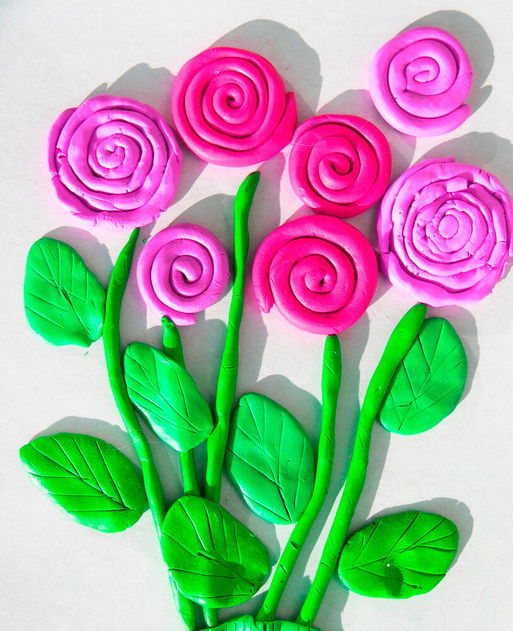
The palette in such drawings will be much richer, the work will be much more beautiful when plasticine of similar shades is rolled together, but without achieving color uniformity. To obtain a festive candy, you will need to carefully twist a pair of thin bright flagella (obtained by squeezing out of a syringe). Then they need to be rolled into a spiral.
Operating rules
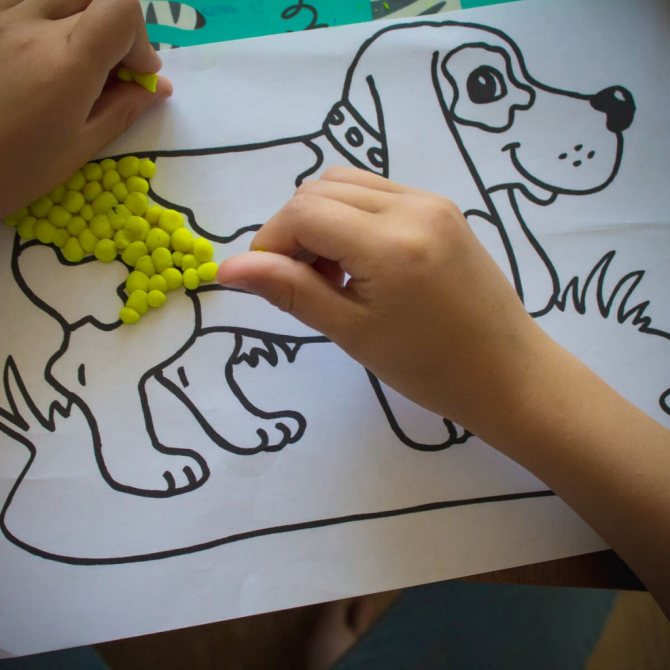
Learning the plasticineography technique occurs quickly. Children simply need to tear small pieces of the desired color from a piece of material, and then make small balls out of them. These elements need to be glued to a sheet of paper with an image drawn on it in the right place. After placing the next part of the picture on the surface, lightly press it with your finger. This procedure is convenient because it allows you to correct mistakes without any extra effort.
When a child creates a plasticine image on a canvas, it is necessary to follow this procedure. In your work, use only bright material that can be easily given the required shape. This will make it easier for pens that are not yet too strong to create exclusive drawings.
To consolidate the acquired skills, separate the stages of training: first show how to press on the material, then practice smearing it. Then combine both methods in the game.
What you need to have
It is advisable to select plasticine that is pliable and soft enough so that the child can change the shape of the element without effort. A wax or other safe mass will do. There is no need to look for multi-colored products - the main thing is that the shades mix well and are bright. Be sure to buy white and black materials to demonstrate to your little one how the transformation of color saturation occurs.
At the first stages of classes, you need to prepare for work:
- rolling board;
- images printed on cardboard or plastic;
- sticks, molds;
- decorations to give the drawing a festive look;
- pastry syringe (it’s easy to squeeze out sausages);
- wide tape (useful for gluing a drawing before work, so that it becomes convenient to quickly correct mistakes);
- wet wipes to wipe plasticine-stained hands.
Drawing with scratches and dents
This technique can be used even by three-year-old children. First, any surface must be covered with a layer of plasticine. Then hand the child a thin wooden stick and invite him to use it to draw any patterns on the material. For older children, such a tool will help to detail the finished image, giving it realism by creating additional volume.
Fine scratches are made by fluffy spruce paws and the luxurious tail of a red fox. With a sharp stick, it’s easy to draw thin scales covering the body of multi-colored fish. Children can use special molds to squeeze out finished figures on a smeared layer of plasticine. Preschoolers love to create amazing ornaments in a similar way. To do this, instead of solid silhouettes, small stamps are used, which can be pasta and decorative buttons. A tool that has a hemisphere at the tip is convenient for making indentations in the locations of the eyes of fairy-tale characters or animals.
The technique of drawing with plasticine is a great option for creative games with kids. Using this technique, children are able to create original greeting cards for parents, New Year’s crafts, and competition tasks. There are extremely many different techniques and little tricks in making plasticine canvases; there is huge scope for the imagination of the young artist.

The benefits of drawing with plasticine
Children intuitively try to diversify their daily activities, since they need to learn a lot, learn almost everything on their own.
This is useful for all-round development. Replacing learning activities with creative experiments allows you to improve cognitive skills, awaken the ability to dream, imagine, and think outside the box. Drawing is an accessible and most favorite type of activity for children of any age. The means of fine art have no restrictions: you can use pencils, sand, plasticine, or just your finger, moving it along the frosted glass. The process actively develops fine motor skills in children. When using a brush, the hand learns to hold a pen for writing; working with sand allows you to enhance tactile sensations, incredibly calming the baby. Modeling with plasticine strengthens the fingers, encourages accuracy, giving scope for creative imagination.
Mosaic of balls
A similar technique for children's plasticineography is available to most children. When the child learns to independently roll small spheres from the material, offer him the task of filling the pre-drawn outline with these multi-colored lumps, without pressing the plasticine too much to the surface. This activity perfectly develops imagination and fine motor skills. When performing the exercise, you will be able to color the most fantastic drawing, giving it volume.
Any errors in the work can be easily corrected - you just need to move the colored ball to the right place.
